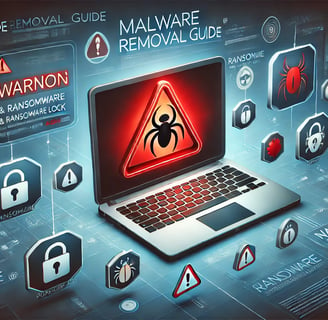Malware Removal Guide: A Step-by-Step Process for Cleaning an Infected Computer
When malware infiltrates your computer, it can compromise your data, degrade performance, and potentially lead to identity theft. Follow this step-by-step guide to remove malware and regain control of your device.
CYBERSECURITY


Step 1: Identify the Infection
Before diving into removal, recognize the common signs of malware, such as:
Slow performance: Programs take longer to load or may freeze unexpectedly.
Pop-ups and unwanted ads: Excessive, intrusive ads that weren't present before.
Changes in browser settings: Homepage, search engine, or new tabs change without your permission.
Unknown programs: New software appearing without installation.
Disabled security software: Some malware attempts to disable antivirus and firewall software.
If you’re seeing any of these signs, your system may be infected.
Step 2: Disconnect from the Internet
To prevent malware from communicating with servers, spreading further, or compromising additional data, immediately disconnect your device from the internet.
Turn off Wi-Fi or unplug the Ethernet cable.
Disable Bluetooth and other wireless connections.
Staying offline also helps avoid any backdoor channels that may allow hackers to access your data.
Step 3: Enter Safe Mode
Safe Mode starts your computer with a minimal set of drivers and programs, which often prevents malware from running.
For Windows:
Restart your computer.
Press F8 (or Shift + Restart in Windows 10) before the Windows logo appears.
Select Safe Mode or Safe Mode with Networking from the boot menu.
For macOS:
Restart your Mac.
Hold down the Shift key during startup.
Release it once you see the Apple logo.
Step 4: Delete Temporary Files
Removing temporary files can free up disk space and potentially eliminate malware. For Windows:
Open Disk Cleanup by searching for it in the Start Menu.
Select the drive you want to clean, usually C:.
Choose Temporary files and other unnecessary items.
Click OK to delete these files.
For macOS, you can use Finder > Go > Go to Folder and enter ~/Library/Caches to clear the cache manually.
Step 5: Run a Malware Scanner
Now, it’s time to use antivirus software to scan for infections. There are free and paid malware removal tools available:
Free tools: Malwarebytes, Bitdefender Free, and Avast Free Antivirus.
Paid tools: Kaspersky, Norton, and McAfee offer advanced features for real-time protection and threat removal.
Download the antivirus software (you may need to connect to the internet temporarily).
Install and update the software.
Run a full system scan in Safe Mode.
Let the antivirus tool detect and quarantine malicious files. After the scan, review the results and follow the prompts to remove any threats.
Step 6: Remove Suspicious Programs and Extensions
Manually check for unknown programs and browser extensions, as these can sometimes evade automatic scans.
Windows: Go to Control Panel > Programs > Programs and Features and uninstall suspicious software.
macOS: Open Finder > Applications and move unwanted programs to the Trash.
For browsers:
Go to Settings or Extensions (usually found in the menu).
Remove any add-ons, plugins, or extensions that you don’t recognize or haven’t installed yourself.
Step 7: Check for Suspicious Startup Programs
Malware can often add itself to startup processes. Checking startup programs can prevent malware from launching.
Windows:
Open Task Manager by pressing Ctrl + Shift + Esc.
Go to the Startup tab and disable suspicious programs.
macOS:
Open System Preferences > Users & Groups.
Go to Login Items and remove any unknown items from the list.
Step 8: Restore System Settings (Optional)
If your system continues to behave abnormally, you may need to restore settings to a point before the infection.
Windows: Use System Restore:
Search for System Restore in the Start Menu.
Choose a restore point from a date before the infection.
macOS: Use a Time Machine to restore the system to a previous state.
Note: System Restore won’t delete personal files but may remove recent apps and drivers.
Step 9: Update Your Operating System and Software
Keeping your system and apps up to date can prevent future infections, as many malware attacks exploit outdated software vulnerabilities.
Update Windows via Settings > Update & Security > Windows Update.
For macOS, go to System Preferences > Software Update.
Ensure all applications are up-to-date, especially browsers, plugins, and commonly used software.
Step 10: Restart and Rescan
After removing the malware, restart your computer in normal mode and run another malware scan to verify that your system is clean. If the scan shows no threats, your system is likely safe.
Preventing Future Infections
Install antivirus software: Always keep it up-to-date with real-time protection enabled.
Be cautious with downloads and emails: Avoid downloading files or clicking on links from untrusted sources.
Use strong passwords: Regularly update passwords and enable two-factor authentication where possible.
Enable firewall protection: Most operating systems have a built-in firewall that you can enable via the security settings.
By following these steps, you can effectively remove malware and restore your computer's health. Regular scans, system updates, and safe browsing habits will further reduce your risk of reinfection. Remember, prevention is always easier than dealing with a full-blown infection!
